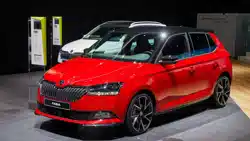Loading ...
Loading ...
Loading ...

Traction control (TCS)
Fig. 218
Key for the TCS system
Read and observe on page 175 first.
The TCS prevents the drive wheels from spinning. TCS reduces the drive pow-
er transmitted to the wheels in the case of slipping wheels. Thereby, for exam-
ple, driving on road surfaces with low grip is made easier.
During a TCS intervention, the indicator light
flashes in the instrument clus-
ter.
Deactivation
›
Press the
» Fig. 218 button.
›
or: In the Infotainment system, press the
button, then tap the function
surface
→
ESC system:
→
ASR off
.
During deactivation the warning light lights up in the instrument cluster
and
an appropriate message is displayed in the instrument cluster.
Activation
›
Press the » Fig. 218 button.
›
or: In the Infotainment system, press the
button, then tap the function
surface →
ESC system:
→
Activated
.
During activation extinguished the warning light is and an appropriate mes-
sage is displayed in the instrument cluster.
The TCS should normally always be enabled. The system should be deactivated
only in the following situations, for example.
▶
When driving with snow chains.
▶
When driving in deep snow or on a very loose surface.
▶
When “rocking a car free” when it has become stuck.
Electronic Differential Lock (EDL and XDS)
Read and observe on page 175 first.
EDL prevents the turning of the respective wheel of the driven axle. EDL
brakes a spinning wheel if required and transfers the drive power force to the
other drive wheel. Driving becomes easier on road surfaces with different
traction under each wheel of the driven axle.
EDL switches off automatically to avoid excessive heat generation on the
brake of the wheel being braked. Once the brakes have cooled down, there is
an automatic re-activation of EDL.
XDS+ is an extension to the electronic differential lock (EDL). The XDS+ re-
sponds to the release of pressure on the wheels during fast cornering by
means of a braking intervention on the wheel on the inside of the corner on
the driven axle. By decelerating the individual wheels, this prevents the vehicle
from over-steering or understeering. This has a positive effect on the driving
stability and steerability of the vehicle.
Brake Assist (HBA)
Read and observe on page 175 first.
HBA increases the braking effect and helps to shorten the braking distance.
The HBA is activated by very rapid depression of the brake pedal. To achieve
the shortest possible braking distance, the brake pedal must be applied firmly
until the vehicle has come to a complete standstill.
HBA is automatically switched off when the brake pedal is released.
Hill Start Assist
Read and observe on page 175 first.
When driving on slopes, Hill Start Assist (hereinafter referred to simply as the
system) allows you to move your foot from the brake pedal to the accelerator
pedal without the vehicle rolling downhill on its own.
The vehicle is braked by the system for about 2 seconds after releasing the
brake pedal.
The system is active as of a 5% slope, if the driver door is closed. The system is
only ever active on slopes when starting off in forward or reverse.
176
Driving
Loading ...
Loading ...
Loading ...
